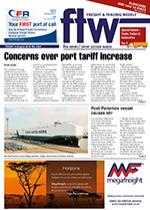As efforts get underway to deepen South Africa’s busiest port, Transnet Port Terminals (TPT) is hoping to keep disruptions to operations at the Port of Durban to a minimum.
Speaking at a business stakeholder meeting in Cape Town, TPT chief executive, Nozipho Sithole, said mitigating any disruptions to operations was the top priority.
“The deepening of the berths is the big project and we are going to have to deal with this for the next five years as we mitigate any operational disruptions,” she said. “We are meeting with shipping lines and various other industry role-players and stakeholders on a one-onone basis on this project.”
She said an integrated approach was being taken between all of the Transnet departments in an effort to address disruptions and to keep communication channels open. “This project is a major undertaking but we are speaking to our customers on an ongoing basis,” she said.
With the Durban Container Terminal (DCT) being not only the busiest but also the biggest in the southern hemisphere, currently handling at least 64% of the country’s seaborne container traffic, disruptions to operations at the terminal can have far-reaching effects. Sithole encouraged port users to therefore engage with TPT on any concerns around the project as well as any possible impact they foresaw it having on their operations.
Berths 203 to 205 at DCT will be deepened from 12.8m to 16.5m and lengthened from 914m to 1 210m to enable the terminal to handle three 350m vessels simultaneously. This will raise capacity from 2.4 million TEUs to 2.9-million TEUs at Pier 2.
This is part of the larger port upgrade and expansion project that is aimed at increasing DCT’s overall container handling capability. Also at DCT, Pier 1 expansion will increase capacity to 2.4 million TEUs. The entire project, said Sithole, would see DCT’s overall capacity go from 3.6 million TEUs to 5.3 million.
INSERT
Capacity at Durban Container Terminal set to increase from 3.6 million to 5.3 million TEUs.

